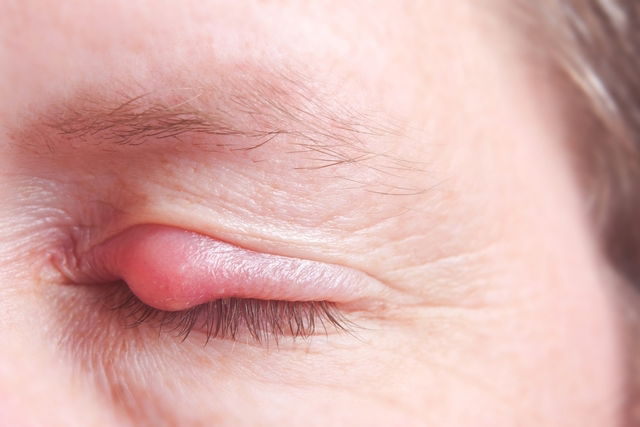A sty is the inflammation of a gland on the eyelid, which happens due to a bacterial infection. It leads to the appearance of a swollen lump, redness, discomfort and itchiness on the eyelid.
Even though they can be very uncomfortable, styes normally resolve on their own within three to five days without the need of any specific treatment.
When styes do not disappear after eight days, or if they worse overtime, you should see your doctor for assessment. The sty at this point can develop into a chalazion, which needs to be treated with a small surgical procedure.

Main symptoms
The main symptoms of a sty in the eye are:
- Ball or lump on the upper or lower eyelid
- Lump with a small yellow dot in the center
- Redness at the site
- Swollen eyelid
- Itching
- Increased temperature in the area
- Sensation of specks in the eye
- Pain or discomfort, especially when blinking
- Increased sensitivity to light
- Excessive tearing of the affected eye.
Furthermore, visual impairment may occur due to pressure on the cornea if the stye is very large.
Possible causes
Styes occur mainly due to infection by microorganisms, most often bacteria like Staphylococcus aureus, which promote local inflammation and lead to the appearance of symptoms.
Some factors can contribute to the appearance of a sty, such as:
- Seborrheic dermatitis
- Rosacea
- Chronic blepharitis
- Diabetes
- High cholesterol
In addition, styes can also occur due to an infection of the Zeiss or Moll glands, which can can occur with wearing contact lenses that are not properly disinfected. Other causes include going to bed without removing eye makeup, using makeup that has expired, or touching your eyes with dirty hands.
Are styes contagious?
Although they are caused by a bacterial infection, styes are not contagious. They are caused by bacteria that normally live on the skin.
Confirming a diagnosis
The diagnosis of a sty is made by a family doctor or ophthalmologist through the evaluation of the patient's, health history, and a physical assessment to determine whether there are any foreign bodies or trauma in the eye. The doctor will look at the characteristics of the lesion on the eyelid, such as size and location, as well as when it developed and how long the symptoms have been present.
Treatment options
Treatment for styes should be guided by an ophthalmologist, who may recommend home remedies or prescribe medications.
The main ways to get rid of a sty are:
1. Warm compresses
Your doctor may recommend applying warm compresses to the affected eyelid for 10 to 15 minutes, 3 or 4 times a day. This will help to reduce inflammation, pain and discomfort, and promote the drainage of pus.
The sty generally reduces in size and drains on its own in about 5 days, and does not usually last more than one week.
2. Medication
In some cases, in which the sty takes longer to resolve and shows sign of a worsening infection, the doctor may prescribe antibiotics in the form of eye drops or ophthalmic ointments.
Furthermore, in more serious cases, the use of oral antibiotics may be recommended.
3. Draining the sty
In cases of a very large sty, the doctor may also drain the pus from the lump on the eyelid.
Read more about how to treat a sty and the treatment options available.
Other care considerations
The main self-care options for stye are:
- Clean the area around the eyes, and do not let too much secretion accumulate;
- Lightly massage the eyelid to help drain the gland;
- Clean the affected eyelid with saline solution, using sterile gauze, which must be changed after each cleaning;
- Do not touch the area too much, as this may worsen the inflammation;
- Do not use makeup or contact lenses, to avoid spreading the lesion, making it bigger, and not making it last longer.
Furthermore, it is important not to squeeze the lump from the eyelid, as this can spread the infection to other parts of the eye and make treatment longer.
Also recommended: How to Get Rid of a Stye: 5 Easy Home Remedies tuasaude.com/en/how-to-get-rid-of-a-styeAre styes curable?
Styes can be cured when self-care and treatment recommended by an ophthalmologist are followed.
When to go to the doctor
It is important to consult an ophthalmologist if you experience the following symptoms:
- Very red and irritated eyes
- Change in vision
- Symptoms do not disappear within 7 days
- When the inflammation spreads across the face, leading to the appearance of a red, hot and pain
After evaluation, the doctor may prescribe an ointment or eye drops with antibiotics and, in some cases, oral antibiotics for a more systemic approach. In more serious cases, minor surgery may be necessary to drain the pus from the stye.
